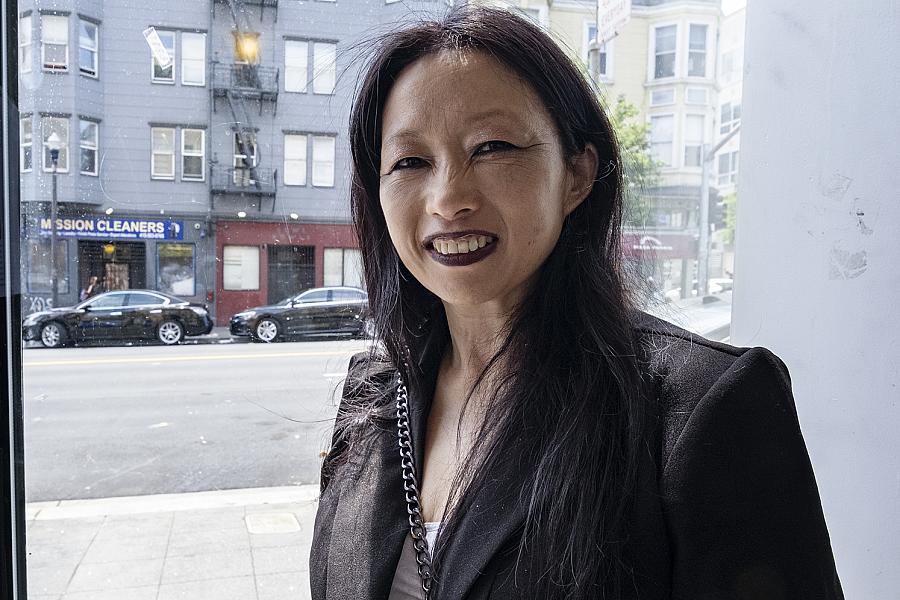What people struggling with homelessness and drug use taught me about San Francisco’s overdose crisis

Tenderloin permanent supportive housing resident Susan Lefever provided insights into how social service providers can foster trust among her building residents, many with long histories of homelessness and substance use disorder, in the podcast series “Civic Presents: San Francisco and the Overdose Crisis,” for the San Francisco Public Press.
Yesica Prado/San Francisco Public Pres
The media appears to embrace a peculiar convention while writing about homelessness and substance use disorder: ignoring the expert opinions of people suffering from those very conditions.
I call this peculiar because where else would we find such a glaring gap in coverage? Would a story on diabetes ignore comments from someone who is insulin dependent? Would a story on childhood vaccinations ignore the voices of parents?
Stories on homelessness and substance use disorder often quote policymakers, academics, elected officials, public health service providers and law enforcement. But people experiencing homelessness or substance use disorder are rarely asked for their opinions or ideas on policy solutions.
Through my 2023 California Health Equity Fellowship project, I discovered that excluding those most affected by this dual public health crisis is not only negligent reporting, but also perpetuates the notion that members of this population have nothing to add to the conversation.
In fact, they can be the most insightful sources.
While creating the “Civic” podcast series “San Francisco and the Overdose Crisis” for the San Francisco Public Press, I interviewed more than 40 people, including several from groups typically marginalized by media. By including their perspectives, I hoped to foster a sense of solidarity with the most vulnerable members of the community and enable those who haven’t experienced the same circumstances to perceive themselves as connected and part of the same human condition.
Among the people I turned to was Adriel Cota, the former client of a recently shuttered drop-in center for unhoused people in downtown San Francisco that offered hygiene services, basic medical care, food assistance and referrals to treatment. The center had been a temporary emergency response to a surge in overdoses. The staff had allowed people to consume drugs there under medical supervision, a decision that led to more than 300 overdose reversals.
Cota enlightened me on gaps in city services, saying the center was cherished for providing previously unavailable laundry amenities and showers. He also told me about potential management issues at the site. He said he knew it was doomed to fail because of its proximity to federal buildings, a popular farmers’ market and illegal street vending, which attracted police activity. His insights inspired me to pursue a valuable line of questioning related to accountability and solutions in my interviews with policymakers and elected officials.
I also gained valuable understanding from Susan Lefever, a drug user who had volunteered to participate in a groundbreaking new program that trained permanent supportive housing residents as on-call overdose responders. A resident in trouble, could push a button to summon Lefever, who would immediately respond carrying overdose reversal medication.
Residents of these single-room occupancy buildings often have long histories of homelessness and substance use disorder. They achieve stability through a harm reduction approach to housing, counseling and treatment that doesn’t demand abstinence from drug use, as would a treatment-first model.
Lefever said that her status as a peer fosters confidence among the other supportive housing residents, who can be distrustful of authority. If something goes wrong, they’re more likely to reach out to her than to the building’s staff. She added that the responsibility and faith that program organizers placed in her has renewed her sense of pride.
“It feels like I’m useful, that I have a sense of purpose,” she said.
Before we started talking, I felt compelled to assure her that at any point, she could request that a comment be taken off the record. An old-school journalist might raise an eyebrow at this — we’re not supposed to give sources this amount of control over a story. But I couldn’t approach her without acknowledging that media coverage often stigmatizes people in her situation.
It turns out that Lefever had previous experience with media — she was briefly quoted for a story in a major daily newspaper about this new program.
She said that experience with a journalist had left her feeling used: “She talked to me for, like, a couple of minutes, and I could tell she was just waiting for one quote.”
I can imagine the reporter’s situation: The deadline is looming, and the story needs just one personal quote — typically called “color.” But this hurried approach ignored the fuller story. And it unintentionally insulted someone who had already endured enough mistreatment for a lifetime.
Just as Lefever is able to help her neighbors because they trust her, we as journalists can better serve our communities when reporting on sensitive issues by remembering that people trust us not only to be their eyes and ears, but also to share their words and experiences with care and respect.

